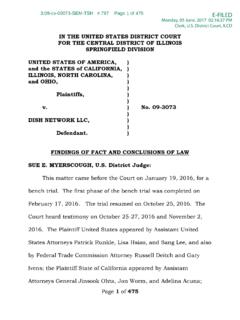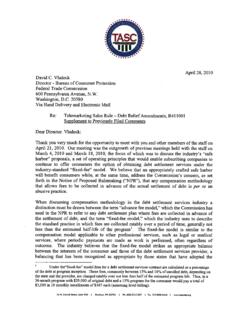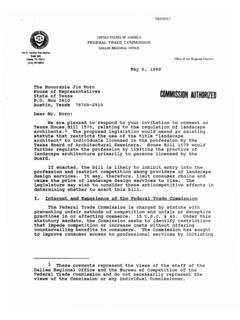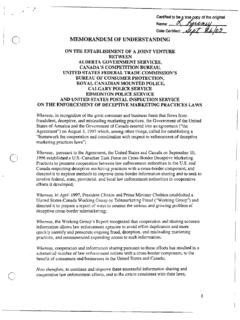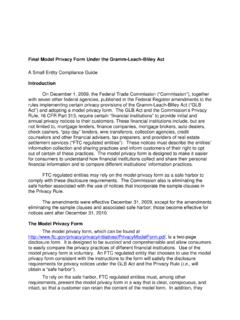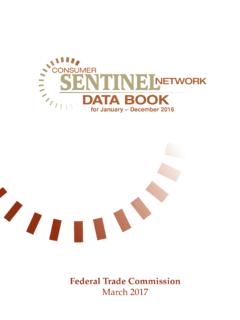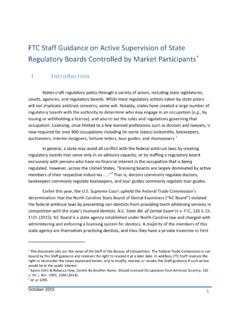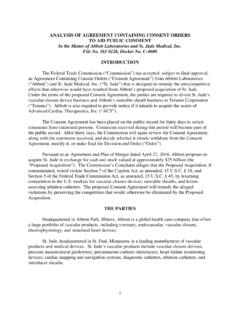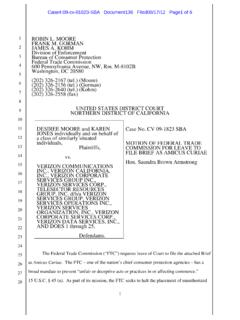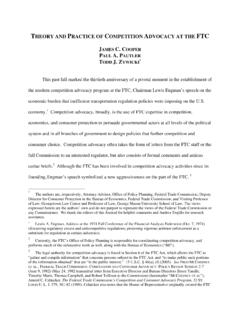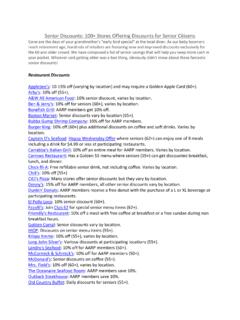Transcription of Slotting Allowances in the Retail Grocery Industry
1 Slotting Allowances in theRetail Grocery Industry :November 2003 Selected Case Studiesin Five Product CategoriesFEDERAL TRADE COMMISSIONAn FTC Staff StudyFEDERAL TRADE COMMISSION TIMOTHY J. MURIS Chairman MOZELLE W. THOMPSON Commissioner ORSON SWINDLE Commissioner THOMAS B. LEARY Commissioner PAMELA JONES HARBOUR Commissioner Susan A. Creighton Director, Bureau of Competition J. Howard Beales III Director, Bureau of Consumer Protection Luke Froeb Director, Bureau of Economics William E. Kovacic General Counsel Anna H. Davis Director, Office of Congressional Relations Rosemarie A. Straight Executive Director Federal Trade Commission Staff Susan S.
2 DeSanti, Deputy General Counsel for Policy Studies, Office of General Counsel William E. Cohen, Assistant General Counsel for Policy Studies, Office of General Counsel Daniel S. Hosken, Deputy Assistant Director, Bureau of Economics Patricia Schultheiss, Attorney, Bureau of Competition John M. Yun, Economist, Bureau of Economics Shawn W. Ulrick, Economist, Bureau of Economics H. Gabriel Dagen, Assistant Director, Bureau of Economics Mark Frankena, Associate Director, Bureau of Economics George Deltas, Economist, Formerly Bureau of Economics Daniel P. O Brien, Economist, Bureau of Economics Joseph E. Remy, Senior Analyst, Bureau of Economics Matthew Bye, Attorney, Office of General Counsel David Conn, Attorney, Bureau of Competition Inquiries concerning this Report should be directed to: Patricia Schultheiss, Attorney, Bureau of Competition (202) 326-2877 or Acknowledgements We appreciate the cooperation, time, and effort from various Grocery retailers and suppliers that made this Report possible.
3 Cover Some clip art on the cover obtained under license from Microsoft Corporation. Table of Contents INTRODUCTION AND EXECUTIVE AND OVERVIEW OF THE STUDY S of the Current FTC Staff of the Study s Methodology and Record Keeping of Reasons for Requesting or Receiving Use of Other Business Practices in Connection with Stocking New Allowances and or Partially Exclusive that Affect the Frequency and Amounts of Store Delivery Variability .. , Billing, and Recording Design and Data Slotting allowance the Product-level Data with the Nielsen Scanner a New Product Interpretation and Analysis Based Upon the and Relative Importance of Slotting and Relative Importance of Slotting Allowances in of Slotting Allowances for the Full Sample Statistics, Frequency Distributions of SlottingAllowances.
4 And Related Data Distributions of Slotting of Slotting allowance Payments to First First Year Revenues and Slotting Store Delivery and Slotting Slotting allowance Reasons for Slotting and Other Business Practices Used in Connection with New Product That Affect the Frequency and Amounts of in Connection with DSD Allowances Necessary for a National Product or Partially Exclusive Dealing Arrangementsin the Product Categories Theory and AAccess LetterAPPENDIX BFiguresINTRODUCTION AND EXECUTIVE SUMMARY1 Every year, suppliers propose thousands of new Grocery products, each competing for Retail Grocery store shelf To decide whether to stock a new product, retailers engage in complex and multi-faceted discussions and negotiations with suppliers.
5 Generally, the supplier presents the new product to the retailer s buyer or category manager, attempting to convince the retailer that the product is likely to be successful. The supplier s presentation may provide a sample of the product; information on the cost of the product and the projected financials ( , 1 This Report represents the views of the staff of the Federal Trade Commission; it does not necessarily reflect the Commission s views or the views of any individual Commissioner. 2 Definitions of new product vary. Some retailers define a new product as any product that enters their store with a new Universal Product Code (UPC), even if it is simply a change in the size of the package. Others define a new product as only a truly different product from something already on the market.)
6 Estimates of new Grocery product introductions range from 1,200 to almost 16,000 per year. In testimony presented to the Senate Committee on Small Business in September 1999, the Grocery Manufacturers of America, Inc. cited its 1997 study in reporting that the number of true new products introduced annually is approximately 1,100 to 1,200, rather than the frequently cited number of 20,000. The Department of Agriculture s Economic Research Service reported a peak of over 16,000 new product introductions in 1995, decreasing to 9,145 new products introduced in 2000, with more recent data suggesting a slight increase in 2001 and the first two months of 2002. J. Michael Harris, Economic Research Service/USDA, Food Marketing System, 2002/AER-811 at 8.
7 Recent, but not yet published, research conducted at West Virginia University suggests 16,000 new product introductions in 2000. Ravi Achrol, et al., West Virginia University. sales and expected retailer profits); the marketing plans to promote the product to consumers; and research on purchasing trends and the success of various products in the category. The retailer and supplier also typically discuss funds Slotting , promotional, co-op advertising, or other introductory Allowances or discounts some of which would lower the retailer s per unit purchase cost for an initial period of time. The retailer then decides whether to carry the new product in its stores. Slotting Allowances are one component of this decision process. Slotting Allowances are one-time payments a supplier makes to a retailer as a condition for the initial placement of the supplier s product on the retailer s store shelves or for initial access to the retailer s warehouse space.
8 Over the years, many have examined the use of Slotting Allowances in the Retail Grocery Industry Congress, economists, marketing experts and other Grocery Industry researchers, the Federal Trade Commission, and others. The Retail Grocery Industry , of course, is vast. In 2002, there were approximately 166,135 Retail Grocery stores, 32,981 of which are defined as supermarkets with sales of $2 million or According to the Food Marketing Institute, in 2002, the typical supermarket was 44,000 square feet in size and carried an average of 3 , (last visited on August 5, 2003). According to the Food Marketing Institute ( FMI ), a Grocery store is [a]ny Retail store selling a line of dry Grocery , canned goods or nonfood items plus some perishable items.
9 The FMI defines a supermarket as [a]ny full-line self-service Grocery store generating a sales volume of $2 million or more annually. Id. ii35,000 items (SKUs).4 Retail Grocery store sales in 2002 were $ billion, of which $ billion was attributable to supermarket At a September 2000 hearing, the Senate Committee on Small Business & Entrepreneurship, under the leadership of Chairman Christopher Bond and Ranking Member John Kerry, requested that the FTC conduct a study of Slotting Allowances in the Grocery Congress formalized this request in the Conference Report accompanying 4577, Commerce, Justice and State Appropriations for Fiscal Year 2001. The report stated that [o]f the funds recommended for the Bureau of Competition, the Committee expects the FTC to expend up to $900,000 for the completion of its investigation into Slotting Allowances in order to ensure fair competition in the Retail Grocery business.
10 7 4 Id. SKU is a common abbreviation for stock-keeping unit, which, according to the FMI, is a number that identifies each separate brand, size, flavor, color, or pack of a product. , (last visited on September 2, 2003). 5 Id. 6 After a hearing in September 1999, the United States Senate Committee on Small Business & Entrepreneurship had requested that the General Accounting Office (GAO) conduct a study of the use of Slotting Allowances and other related fees in the Retail Grocery Industry . The GAO, however, was unable to obtain the necessary proprietary information from retailers and manufacturers to conduct such a study and reported this fact in testimony delivered on September 14, 2000, before the U.
